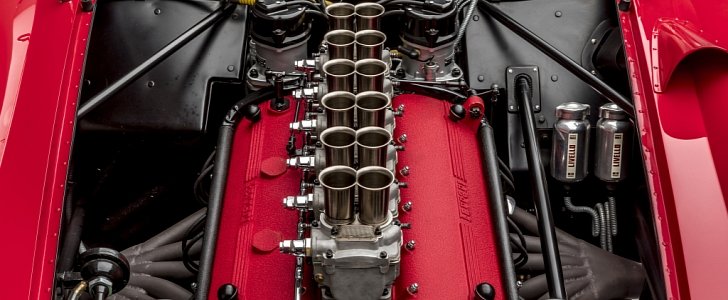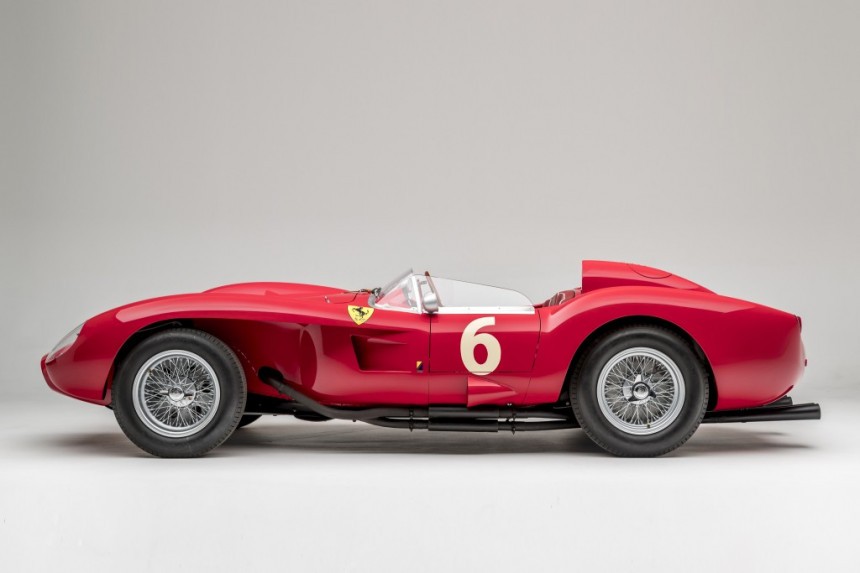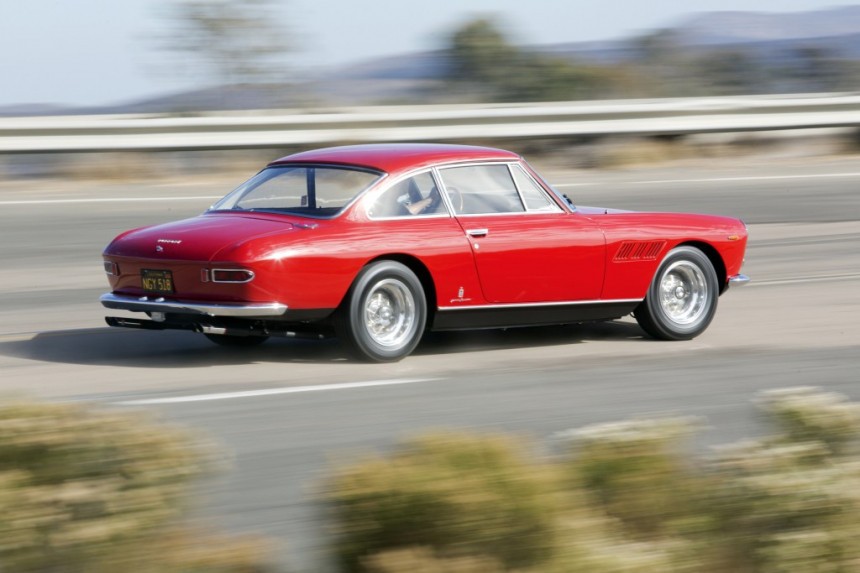Care to guess which is the longest-running engine design from Ferrari? The answer is rather obvious given the headline of this story, and there are many reasons why the Prancing Horse sticked to this mechanical paragon from 1947 through 1989.
First and foremost, Gioacchino Colombo is the name of the Italian engineer who designed the Colombo V12. At one point, Enzo Ferrari asked Gioacchino about this powerplant's competitiveness, and the answer was rather obvious.
Maserati was running four cylinders in the 4CL and 4CLT single-seat racing cars, British brands like Jaguar had inline-six engines, Alfa Romeo had a straight-eight blunderbuss, and this is how the Italian upstarts settled for 12 cylinders in the 125, the first vehicle to bear the Ferrari nameplate.
To whom it may concern, 125 designates the capacity of each cylinder. Multiplying by 12 results in 1,500 cubic centimeters, which is petite when you compare it to modern-day leviathans with over six liters of displacement.
Giuseppe Busso, best known for creating Alfa Romeo’s Busso V6, collaborated on the design alongside Luigi Bazzi, the man who helped Alfa Romeo win the first Formula 1 championship with the 158 and Nino Farina in the driver’s seat. The funny this is, Il Commendatore was extremely close to pulling the plug on his racing ambitions because of the sheer costs of running Scuderia Ferrari. The Colombo V12, however, convinced Enzo Ferrari to keep going forward.
The Grand Prix Compressore version of the 125 – alternatively called 125 F1 – finished the 1948 Italian Grand Prix in Valentino third in the hands of French racing driver Raymond Sommer. It’s this podium finish that eased the heart of the head honcho, but the financial struggles continued for the Italian entrepreneur.
Enzo understood that he has to sell cars to the public to keep the business afloat, and this is how the race-bred design became available to everyone for the right price. Luigi Chinetti, an Italian-born racecar driver who took outright victories at the 24 Hours of Le Mans three times and Spa twice, is responsible for importing the first Ferraris to the United States of America. If you were wondering, the first-ever U.S. import is the 166 MM Touring Barchetta, chassis number 0002 M.
Moving past the 166, 195, and 212 models, let’s talk about the highly sought-after Colombo 250. Gioacchino left Ferrari in 1950, but his design evolved into a 3.0-liter in the early 1950s. Based on auction results, this engine powers the most desirable Prancing Horses of all time. The 250 GTO racing car and 250 GT Berlinetta Lusso made cool by The King of Cool are two models that feature the Colombo 250 engine. Oh, and by the way, the most expensive Ferrari ever is 250 GTO 4153 GT, evaluated at anything between $70 million and $80 million.
A single overhead camshaft on each cylinder bank, 60 degrees between the cylinder banks, and two valves per cylinder may lead you into believing the 250 isn’t all that different from the 125. The truth of the matter is, this engine proved itself far more successful in motorized competitions, starting with the 250 S Berlinetta Vignale that won the 1952 Mille Miglia. Giovanni Bracco and Alfonso Rolfo drove the racing car 1,574 kilometers in 12 hours and 9 minutes, averaging 128.5 km/h.
The Colombo with 3.0 liters of displacement is also responsible for the first mid-engined sports prototype developed by Ferrari, the 250 P. Ferrari had immediate success with this car at endurance events such as Le Mans, Sebring, and the ‘Ring, driven hard by legends that include John Surtees and Lorenzo Bandini.
Not to be confused with the Aurelio Lampredi-designed V12 engine, the 275 series received leveled up to 3.3 liters. The final two models from this family – the GTB/4 and GTS/4 NART Spider – improved on their predecessors with a four-cam setup and 54-degree angle for a more compact design. Also known as Tipo 226, this version of the Colombo 275 engine came standard with six Weber carburetors for an output rating of approximately 300 horsepower.
Four-cam models also have a dry-sump lubrication system, and the oil tank is enormous at 16 liters (16.9 quarts). Having an external oil reservoir isn’t exactly uncommon these days in high-performance vehicles. A few examples include the Mercedes-AMG GT, Acura NSX, McLaren 720S, and Lamborghini Huracan.
The 330 series entered the scene in 1963 with 4.0 liters and an alternator instead of a generator. Modifications to the spark plugs, water pump, and bore spacing translated to outputs as high as 450 horsepower in the 330 P. The 330 LMB, on the other hand, combines elements from the 250 GTO and 250 GT Berlinetta Lusso.
Marque expert Godfrey Eaton famously claimed the 330 “was probably the first Ferrari in which you could actually enjoy a radio,” waxing lyrical about the more refined ride quality and comfort creatures. Fast-forward to 1966, and the 365 series was introduced to much critical acclaim. The 4.4-liter engine was matched with independent rear suspension in the GT 2+2, the most popular model of the 365 series. It’s just about time we start talking about the Daytona, isn't it?
The sharp styling of the 365 GTB/4 marked a departure from the curvy designs of the past, and as you’re well aware, Ferrari loved sharp styling in the 1970s. Only the Daytona had dry-sump lubrication, helping the grand tourer reach the kind of speeds that would’ve made the Lamborghini Miura blush with admiration.
From 1976 onward, the Maranello-based manufacturer started getting lazy with the Colombo V12. The 400 and 412 series were nothing more than improvements from the 365 GT4 2+2, but worse still, you could opt for a three-speed automatic transmission. Believe it or not, more automatics were produced than manuals even though the 400 and 412 were never officially imported to the United States.
As opposed to the 308 from Magnum P.I. and Testarossa from Miami Vice, the 400 and 412 didn’t get too much screen time either because of the rather bland styling. There is, however, an exception. French duo Daft Punk drove a black example of the breed in Electroma, a science fiction movie about two robots trying to become human. As a side note, it’s a very good watch if you’re into existentialism.
Turning our attention back to the Colombo V12 engine, what happened after the 400 and 412? We’ll first have to go back to 1973 when the Berlinetta Boxer was introduced, featuring a flat-12 engine that’s more correctly identified as a 180-degree V12. The Testarossa continued with this architecture until 1996.
It took Ferrari a few years, but the Colombo was eventually replaced in 1992 by an all-new design. The F116 in the 456 GT and F133 in the 550 Maranello enjoyed tremendous success right off the bat, and ten years later, the F140 family joined the party in the supercar that bears Il Commendatore’s name – the Ferrari Enzo.
The conclusion, therefore, is simple. Gioacchino's masterpiece has opened Enzo’s eyes about his racing and road-going cars, embracing the V12 arrangement as the brand’s flagship engine option. The Colombo has also helped Ferrari and Scuderia Ferrari build the most revered image in the biz, embodying a philosophy that other automakers and racing teams simply cannot replicate.
Maserati was running four cylinders in the 4CL and 4CLT single-seat racing cars, British brands like Jaguar had inline-six engines, Alfa Romeo had a straight-eight blunderbuss, and this is how the Italian upstarts settled for 12 cylinders in the 125, the first vehicle to bear the Ferrari nameplate.
To whom it may concern, 125 designates the capacity of each cylinder. Multiplying by 12 results in 1,500 cubic centimeters, which is petite when you compare it to modern-day leviathans with over six liters of displacement.
Giuseppe Busso, best known for creating Alfa Romeo’s Busso V6, collaborated on the design alongside Luigi Bazzi, the man who helped Alfa Romeo win the first Formula 1 championship with the 158 and Nino Farina in the driver’s seat. The funny this is, Il Commendatore was extremely close to pulling the plug on his racing ambitions because of the sheer costs of running Scuderia Ferrari. The Colombo V12, however, convinced Enzo Ferrari to keep going forward.
The Grand Prix Compressore version of the 125 – alternatively called 125 F1 – finished the 1948 Italian Grand Prix in Valentino third in the hands of French racing driver Raymond Sommer. It’s this podium finish that eased the heart of the head honcho, but the financial struggles continued for the Italian entrepreneur.
Enzo understood that he has to sell cars to the public to keep the business afloat, and this is how the race-bred design became available to everyone for the right price. Luigi Chinetti, an Italian-born racecar driver who took outright victories at the 24 Hours of Le Mans three times and Spa twice, is responsible for importing the first Ferraris to the United States of America. If you were wondering, the first-ever U.S. import is the 166 MM Touring Barchetta, chassis number 0002 M.
A single overhead camshaft on each cylinder bank, 60 degrees between the cylinder banks, and two valves per cylinder may lead you into believing the 250 isn’t all that different from the 125. The truth of the matter is, this engine proved itself far more successful in motorized competitions, starting with the 250 S Berlinetta Vignale that won the 1952 Mille Miglia. Giovanni Bracco and Alfonso Rolfo drove the racing car 1,574 kilometers in 12 hours and 9 minutes, averaging 128.5 km/h.
The Colombo with 3.0 liters of displacement is also responsible for the first mid-engined sports prototype developed by Ferrari, the 250 P. Ferrari had immediate success with this car at endurance events such as Le Mans, Sebring, and the ‘Ring, driven hard by legends that include John Surtees and Lorenzo Bandini.
Not to be confused with the Aurelio Lampredi-designed V12 engine, the 275 series received leveled up to 3.3 liters. The final two models from this family – the GTB/4 and GTS/4 NART Spider – improved on their predecessors with a four-cam setup and 54-degree angle for a more compact design. Also known as Tipo 226, this version of the Colombo 275 engine came standard with six Weber carburetors for an output rating of approximately 300 horsepower.
Four-cam models also have a dry-sump lubrication system, and the oil tank is enormous at 16 liters (16.9 quarts). Having an external oil reservoir isn’t exactly uncommon these days in high-performance vehicles. A few examples include the Mercedes-AMG GT, Acura NSX, McLaren 720S, and Lamborghini Huracan.
The 330 series entered the scene in 1963 with 4.0 liters and an alternator instead of a generator. Modifications to the spark plugs, water pump, and bore spacing translated to outputs as high as 450 horsepower in the 330 P. The 330 LMB, on the other hand, combines elements from the 250 GTO and 250 GT Berlinetta Lusso.
The sharp styling of the 365 GTB/4 marked a departure from the curvy designs of the past, and as you’re well aware, Ferrari loved sharp styling in the 1970s. Only the Daytona had dry-sump lubrication, helping the grand tourer reach the kind of speeds that would’ve made the Lamborghini Miura blush with admiration.
From 1976 onward, the Maranello-based manufacturer started getting lazy with the Colombo V12. The 400 and 412 series were nothing more than improvements from the 365 GT4 2+2, but worse still, you could opt for a three-speed automatic transmission. Believe it or not, more automatics were produced than manuals even though the 400 and 412 were never officially imported to the United States.
As opposed to the 308 from Magnum P.I. and Testarossa from Miami Vice, the 400 and 412 didn’t get too much screen time either because of the rather bland styling. There is, however, an exception. French duo Daft Punk drove a black example of the breed in Electroma, a science fiction movie about two robots trying to become human. As a side note, it’s a very good watch if you’re into existentialism.
Turning our attention back to the Colombo V12 engine, what happened after the 400 and 412? We’ll first have to go back to 1973 when the Berlinetta Boxer was introduced, featuring a flat-12 engine that’s more correctly identified as a 180-degree V12. The Testarossa continued with this architecture until 1996.
It took Ferrari a few years, but the Colombo was eventually replaced in 1992 by an all-new design. The F116 in the 456 GT and F133 in the 550 Maranello enjoyed tremendous success right off the bat, and ten years later, the F140 family joined the party in the supercar that bears Il Commendatore’s name – the Ferrari Enzo.
The conclusion, therefore, is simple. Gioacchino's masterpiece has opened Enzo’s eyes about his racing and road-going cars, embracing the V12 arrangement as the brand’s flagship engine option. The Colombo has also helped Ferrari and Scuderia Ferrari build the most revered image in the biz, embodying a philosophy that other automakers and racing teams simply cannot replicate.











































